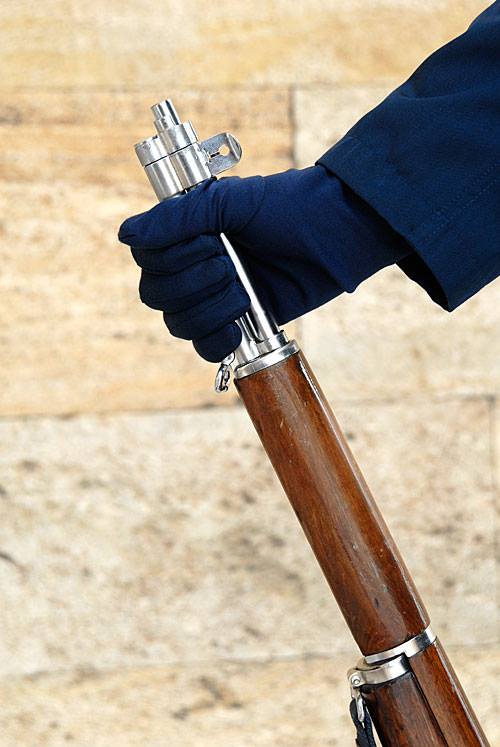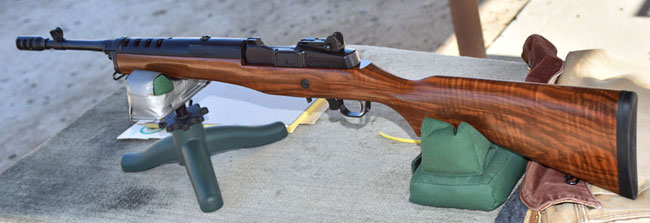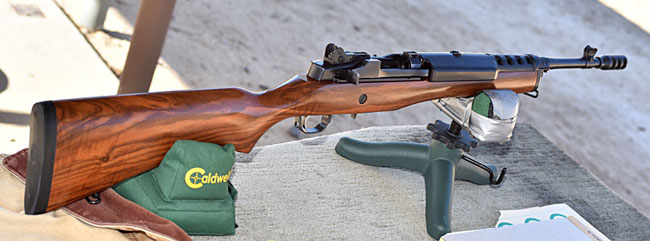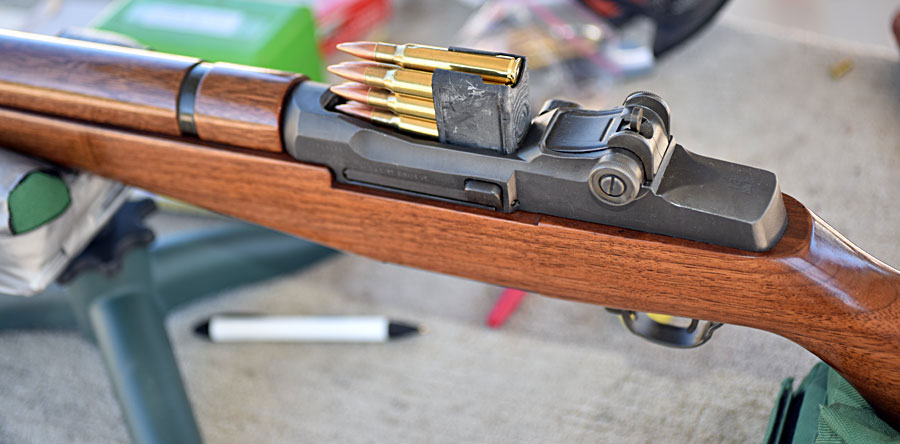This is a tale of three Garand-style rifles, told from my laptop while waiting to make a connection in Taipei. Yep, I have time on my hands (5 ½ hours, to be precise). I had this Garand tale from an earlier writeup, so I thought I would polish it up a bit and post a gun story on the ExhaustNotes blog.
The M1, the M1A, and the Mini 14
The three Garand rifles? They’re all based on John C. Garand’s brilliant rifle known as the M1, so I guess I’ll start with a description of that firearm first. The M1 Garand is a gas-operated, semi-automatic rifle, described by General George S. Patton as the greatest battlefield implement ever invented. In a period when all other armies were using bolt-action rifles, our ability to deliver serious semi-automatic firepower without having to turn a bolt was a major advantage.

The Garand design operates by porting a bit of the combustion gas to a cylinder that drives an operating rod, and then the operating rod unlocks and cycles the bolt. Garand’s genius is evident in the mechanical interactions between the bolt, the operating rod, and the rifle’s receiver. The angles and camming surfaces are such that when the operating rod pushes the bolt rearward, the bolt first rotates and unlocks before it extracts and ejects the spent cartridge case. After it has done that, the rifle’s main spring drives the operating rod forward again, the bolt picks up and chambers a new round, and everything locks into place. It’s very clever. There is no software and there are no electrons carrying any signals. It’s all driven by good old-fashioned, straightforward mechanical stuff.
Several armories and companies manufactured Garands, and serious collectors look for Garand rifles based on their manufacturing pedigree. My M1 Garand is nothing fancy or collectible. It’s a mutt, a hodgepodge of components with an Israeli-manufactured receiver, an Italian Beretta trigger group, and other parts of mixed origin. But it shoots well and I love shooting it, and the Garand is a rifle with a soul. It’s like taming a living beast when you shoot it. It roars, it kicks, it makes mechanical noise, and it sends things flying.

M1 Rifles Standing Guard
I was surprised to see Garands still on guard duty a few years ago when I was on a secret mission in Turkey. I grabbed some cool photos of Turkish sailors and soldiers (young Turks, you could call them) guarding Ataturk’s tomb in Ankara…


Garand originally designed the M1 to fire a cartridge with a 0.27-inch diameter projectile, but when it was fielded, the Army opted to chamber it in .30 06. We already had machine guns and the Springfield 03A3 chambered in .30 06, and sticking with the same round made sense. The M1 Garand soldiered on during World War II and the Korean War for us, and it’s still soldiering on in ceremonial units (like those Young Turks you see above).
The M14 and M1A
After the Korean War, the US Army developed the M14 rifle to replace the Garand. The M14 is essentially a shortened M1 Garand with a magazine (you insert the ammo into the bottom of the rifle). The basic Garand operating concept is the same. The M14 switched from the mighty .30 06 round to the 7.62 NATO round (the .308 Winchester cartridge). The M14 shoots the same bullet, but the 7.62 brass cartridge case is a little bit shorter and the bullet is about 100 feet per second slower than it would be if it was fired from a .30 06. The shorter cartridge case allows the 7.62 NATO round to operate in a machine gun with a higher cyclic rate of fire, and that was one of the reasons we went with it.
The M14 started development in the 1950s and it officially replaced the Garand as the US Army infantry rifle in 1961. I first trained with the M14 when I joined the Army, and I loved it. It was a full-sized rifle with real sights and a real walnut stock (no black plastic silliness in those days), and it fired a serious cartridge. Unlike the Garand, the M14 had a selector switch that allowed it to fire full auto. With those features, what’s not to like?
In addition to being a great service rifle, the M14 was one hell of a target rifle. The M14’s .308 Winchester cartridge is inherently more accurate than the M1 Garand’s .30 06 round (heresy to some, I know, but I’ll stand by that statement). Civilian competitive shooters wanted the M14, but it wasn’t going to happen. So private industry did what America does best: It engineered a solution. The company was the Springfield Armory (not to be confused with the U.S. government’s Springfield Arsenal), and they created and sold semi-auto-only versions of the M14 to the public. Springfield Armory called the new rifle the M1A (not to be confused with the M1 Garand). I know, there’s a lot of “not to be confused” stuff here. It’s complicated.
I always wanted an M1A, and when I spotted one in our local gun shop with nice horizontal figure in the walnut stock, I pulled the trigger (pardon the pun). The finish on a standard Springfield Armory M1A is crude (it’s a single coat of boiled linseed oil on a not-very-smoothly-finished stock). The figure in my rifle’s stock indicated the wood had potential, so I went to work applying multiple coats of TruOil (one hand-rubbed coat each night, just like we used to do in the Army). It turned out well and it shot well, but I reasoned it could do better, so I sent it back to Springfield to have it glass-bedded and I added National Match sights. The glass-bedding stabilizes the action in the stock (it’s a technique for making a rifle more accurate), and the National Match sights have a smaller aperture at the rear and a thinner front sight (that makes it easier to shoot tighter groups). It worked for me; those two changes dropped my M1A’s 50-yard groups from 1.5 inches to 0.5 inches.


The thing about both of the above rifles is they shoot big cartridges. The Garand’s .30 06 and the M14’s 7.62 NATO rounds have serious recoil and muzzle blast. Again, American inventiveness to the rescue: Enter another mechanical genius and business leader extraordinaire, Bill Ruger. Ruger developed what is essentially a scaled-down version of the M14 chambered for the 5.56 NATO cartridge (which is essentially the .223 Remington round). That’s the same cartridge used in the M16. It fires a much smaller bullet than either the M14 or the M1, and the recoil and muzzle blast are substantially lower.
A Favorite: The Mini 14
Ruger called his Garand-based rifle the Mini 14 (it was a smaller version of the M14). It came on the market in the early 1970s and it was an instant hit. I’ve owned several Mini 14s (and fired several more) over the last 5 decades, and I love the things. They are not known for their accuracy, but they are accurate enough and they are a lot fun to shoot.


The Mini 14 never made it into the US military in a major way (it’s rumored that some special forces units were armed with Mini 14s), but it is used by many US police agencies (including the San Bernardino County Sheriff’s Department, one of the best there is), the French military, and the militaries of a few other countries. I believe that if Ruger had come to market with the Mini 14 a few years earlier, it might have become the US Army’s standard rifle instead of the M16 (and that would have been fine by me). That last statement is bound to raise a few eyebrows, but hey, this is the Internet. If you disagree, that’s why we have a Comments section.
I’ve fired thousands and thousands of rounds through my Mini 14, and it is the cartridge I reload the most frequently. The small .223 bullets are inexpensive and reloading is as much fun as shooting. My Mini 14 is the rifle I shoot most and one of these days I suppose I’ll wear out the barrel, but I’m not worried. I’ll just have a new one fitted and shoot another zillion rounds.
More Tales of the Gun? Just click here!
Never miss an ExNotes blog:


Joe – Love your gun stuff. Just got my first Garand and a second one a few months later in .308. The Mini – 14 has been on the list for a long time but will have to wait a while. – Thanks